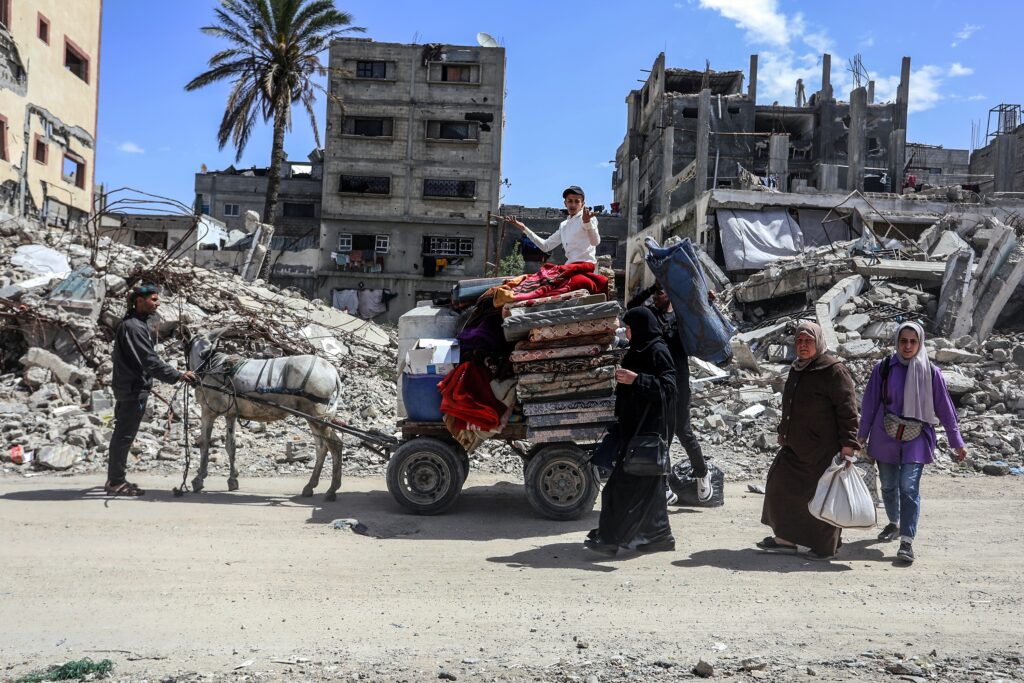At least 50 people were killed overnight in Gaza following a series of Israeli airstrikes, hospital officials said on Thursday. The attacks hit multiple areas, with many of the victims reported to be women and children. The latest strikes come as Israel pushes forward with plans to carve new military corridors through Gaza, increasing tensions and sparking renewed international concern.
Doctors at Nasser Hospital in Khan Younis confirmed the deaths of at least five children among the casualties. The European Hospital in southern Gaza also received 19 more bodies, which included five children and a pregnant woman. At Ahli Hospital in Gaza City, medics reported seven children among those killed.
The rising death toll adds to the mounting civilian toll of the war, now in its 18th month. The conflict began on October 7, 2023, when Hamas launched a surprise attack on southern Israel, killing 1,200 people and taking 251 hostages. Since then, Israel has responded with a campaign of airstrikes, ground raids, and blockades.
Evacuation Orders and Warnings of Force
On Thursday, the Israeli military ordered residents of several Gaza neighborhoods to evacuate immediately. Troops instructed civilians to move westward toward Gaza City’s coastal areas, which they said were safer zones. The army warned that anyone remaining in targeted zones would face “extreme force.”
The warning follows a pattern seen throughout the conflict. The Israeli army often calls for evacuations before launching heavy strikes. However, many civilians say there are few safe places left, as air raids continue across much of the territory.
Netanyahu’s New Security Plan Sparks Backlash
Israeli Prime Minister Benjamin Netanyahu announced plans to open a new military route called the “Morag Corridor.” The new passage will slice through Gaza from east to west, linking Israel directly to the Mediterranean Sea and cutting off Rafah in the south from the rest of Gaza.
This corridor joins the already-established “Netzarim Corridor,” which isolates northern Gaza and allows Israeli forces to move freely between outposts. Netanyahu said the corridors are vital for Israel’s long-term security and help stop weapons smuggling and militant activity.
He compared the Morag route to the “Philadelphi Corridor,” which runs along the Egypt-Gaza border. “We must ensure these areas are never used to attack our people again,” Netanyahu told reporters.
Defense Minister Confirms Expanded Military Zones
Israel’s Defense Minister, Israel Katz, echoed Netanyahu’s stance. He confirmed that Israel would seize more parts of Gaza for what he called “security buffer zones.” Katz said these areas are necessary to keep Hamas from regaining strength and to push for the release of Israeli hostages.
Katz also made a direct appeal to Gaza’s residents, urging them to turn against Hamas and support efforts to end the war. “Hamas is the only thing standing between peace and destruction,” he said in a televised statement.
Palestinian Authority Rejects Corridor Plans
The Palestinian Authority (PA), led by the Fatah party in the West Bank, rejected Israel’s corridor plans. Officials called them illegal and said they violate Palestinian rights. “This is a unilateral move that destroys any hope for peace,” one senior PA official said.
The PA also criticized Hamas for refusing to release hostages and failing to protect civilians. In recent weeks, protests against Hamas leadership have taken place in some areas of Gaza, with people demanding accountability and aid.
Hostage Crisis Still Unresolved
Netanyahu has said Israel will not stop fighting until all hostages are returned. According to Israeli intelligence, 59 hostages remain in Gaza, with 24 believed to be alive. Hamas has demanded a full Israeli withdrawal, a long-term ceasefire, and the release of Palestinian prisoners in exchange.
So far, negotiations mediated by Egypt and Qatar have failed to make progress. Several truce proposals have been discussed but none have been implemented.
Humanitarian Crisis Deepens
Since the war began, Israel has blocked fuel, food, and medical aid from entering Gaza. This has led to a severe humanitarian crisis, with hospitals struggling to treat the wounded and food shortages affecting nearly every household.
More than 90% of Gaza’s 2.3 million people have been displaced. Many now live in overcrowded shelters, schools, or tents. The World Health Organization has warned of rising disease and malnutrition rates.
The destruction of Gaza’s infrastructure is nearly total in some areas. Roads, schools, water systems, and communication lines have been bombed. Aid groups say rebuilding could take decades.
Global Reactions and Appeals for Peace
International pressure is growing for a ceasefire. The United Nations, European Union, and several Arab nations have called for an immediate end to hostilities. U.S. officials have urged Israel to avoid harming civilians and to allow more aid into Gaza.
Despite this, Israel maintains that its military actions are necessary to prevent future attacks and ensure national security. Netanyahu insists that the war is not against civilians but against Hamas, which the United States, European Union, and Israel designate as a terrorist organization.
As military operations intensify, there seems to be little hope for a quick end to the conflict. Israel’s corridor plans suggest a longer-term presence in Gaza. At the same time, civilian suffering continues to rise.
What remains uncertain is whether any resolution—military or diplomatic—can satisfy both sides. Until then, the people of Gaza remain caught in a war that shows no signs of ending.


